- Print
- DarkLight
- PDF
Overview
Cerebrata makes managing the data stored in your file storage relatively painless. Cerebrata provides a complete set of features with full fidelity with Azure File Storage REST API from managing file share-s to files and folder.
Packed with features like upload, download, copy, bulk operations on shares, one-click share restore and more, Cerebrata is essentially the one-stop shop for managing the file storage assets.
Add File Share
Cerebrata offers the capability to create File Shares themselves. It makes developers life more comfortable and saves time switching to Azure Portal to create a File Share.
Following are the steps to create a File Share:
1. Click + button in the File Share node. It will open a dialog box
2. Provide a File Share name and provide Share Quota and Access Tier as required
3. Click Save to add a Storage File Share
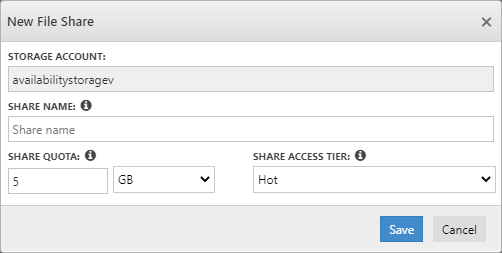
CORS Settings
CORS is an HTTP feature that enables a web application running under one domain to access resources in another domain. Cerebrate also offers the capability to manage CORS Rules from the tool itself. Using Cerebrata, User can create, delete, edit the CORS Rules
Following are steps to create the CORS Rule:
- Select the context menu of the File Share node and click CORS Settings
- It will open a popup showing list of CORS Rules that are already available. User can even the CORS Rules.
- Click New CORS Rule and provide appropriate information like Allowed Domains, Allowed methods, Allowed Headers, Exposed Headers, Max Age
- Click Ok to save the CORS Rule
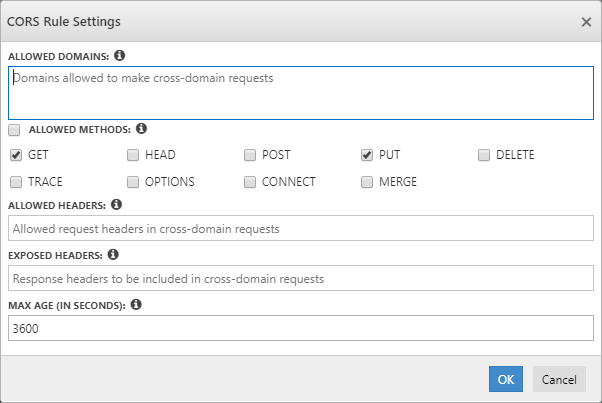
Analytics Settings
Azure Storage Analytics performs logging and provides metrics data for a storage account. You can use this data to trace requests, analyze usage trends, and diagnose your storage account issues. Cerebrata offers options to changes the settings for Azure Storage Analytics as well. Analytics Setting provides two types of settings. they are,
1. Hourly Settings: Hourly settings allows User to log the operations on an Hourly basis along with Retention policy
2. Minutes Settings: Minutes settings allows User to log the operations on every minute along with Retention policy
Delete All Shares
Consider when a QA team created multiple Storage File Shares to perform testing. When the testing is over, the QA engineer would need to delete all the File Shares in a Storage Account. Here comes Delete All Shares option in Cerebrata.
Following are the steps to delete all Storage File Shares:
- Select the context menu of the File Share node and click Delete All Shares
- It will open a popup and ask the User to enter the numbers in the "VERIFICATION CODE" box into "CONFIRM CODE" box beside it.
- Once the Verification code is entered, Click Delete to delete all the File Shares in a Storage Account
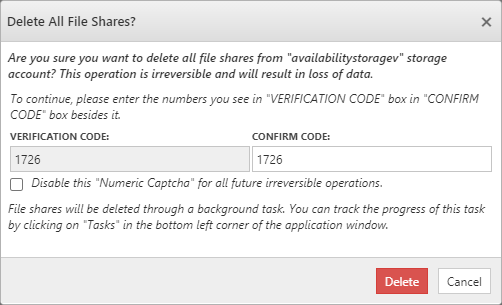
File Shares will be deleted through a background task. You can track the progress of this task by clicking on "Tasks" in the bottom left corner of the application window.
Manage Metadata
User-defined metadata consists of one or more name-value pairs that you specify for a File Share resource. You can use metadata to store additional values with the resource. Metadata values are for your own purposes only and don't affect how the resource
behaves. Using Cerebrata, the User can create, delete, edit the File Share metadata.
Following are the steps to create metadata:
- Select the context menu of the File Share and click Metadata
- It will open a popup "Share Metadata" that shows a list of existing Key-Value metadata
- Click New Metadata and Add Your Key Value Metadata and hit Save
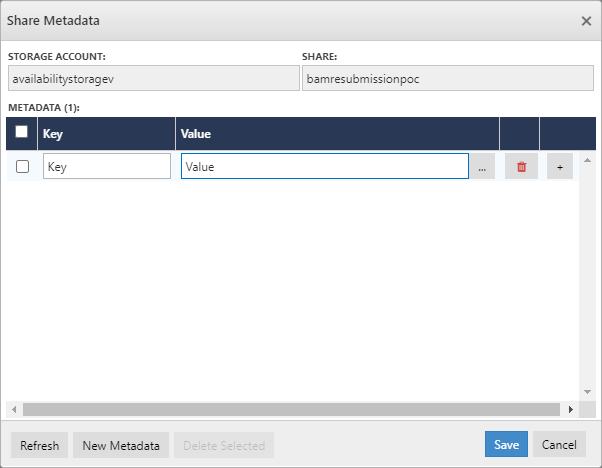
Properties
For Storage File Share, the User can check the Storage File Share properties like the present lease state or when the File Share last modified.
Following are the steps to view the properties of a File Share.
- Select the context menu of the File Share and click Properties
- It will open a popup "File Share Properties" that shows the properties like Lease state, Last modified, ETAG and more.
Change Quota
Using Cerebrata, User can manage quota of a file share. In other words, you can increase or decrease the capacity of a file share.
Following are the steps to change File Share Quota:
- Select the context menu of the File Share and click Change Quota
- It will open a popup "Change File Share Quota" that provides an option to increase or decrease the File Share quota
- Once the Quota provided, Click Save
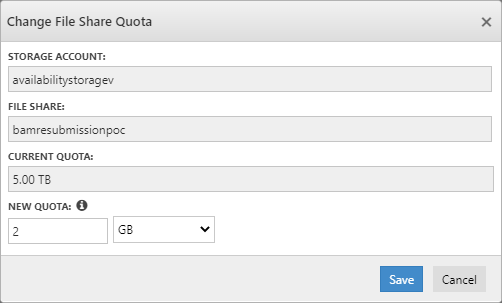
Change Access Tier
Similar to Quota, the User can even change the Access tier of the Storage File Share using Cerebrata.
- Select the context menu of the File Share and click Change Access Tier
- It will open a popup "Change File Share Access Tier" that provides an option to change the access tier to either Hot or Cold
- Once the Access Tier provided, Click Save
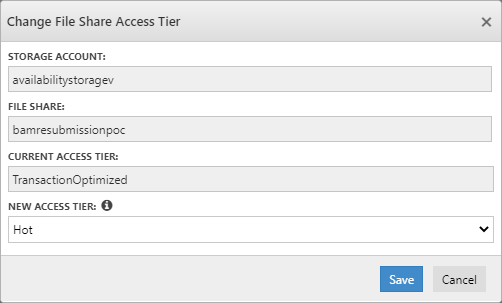
Shared Access Signature & Permissions
Using Cerebrata, User can even manage Shared access Signature for File Shares. It also provides an option to define the access level that needs to be provided for a SAS Token. It also Permissions to manage the Access Policy of the SAS Token. Click here to know about Shared Access Signature
Following are the steps to create SAS Token and URL for Storage File Share by defining the granular access:
- Select the context menu of appropriate Storage File Share and click Shared Access Signature
- This will open a Popup "File Share Shared Access Signature (SAS)"
- Select the level of access that needs to be provided along with the Expiry date of the SAS Token
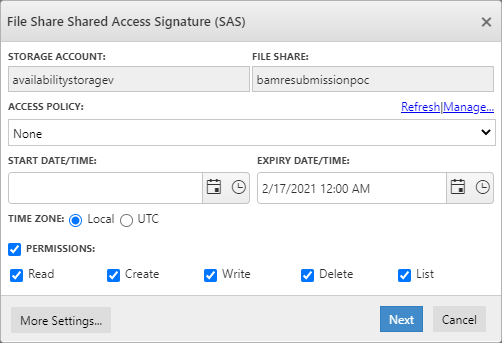
- Click Next to get the SAS URL and Token for the selected Storage File Share.
Cerebrata also offers an option to restrict the IP Address and protocol using Advanced settings. Click More Settings in the left bottom of the dialog to open Advanced SAS Settings.
Export Files/Folders list
Consider if the User wants to export all the File Shares in a CSV format for a Local Backup. Using the Export File Share list, the User can easily export all the File Shares in a File Share.
Following are steps to export the File/Folders list:
1.Select the context menu of appropriate Storage File Share and click Export Files/Folders list
2. It will ask User to select the Folder to which the File Share list needs to be exported
3. Once the Folder is selected, choose the Properties that need to be exported along with Name, URL, Type, Size.
4. Clicking "Export" will trigger a Background Task to export the list of File Shares available in a CSV format.
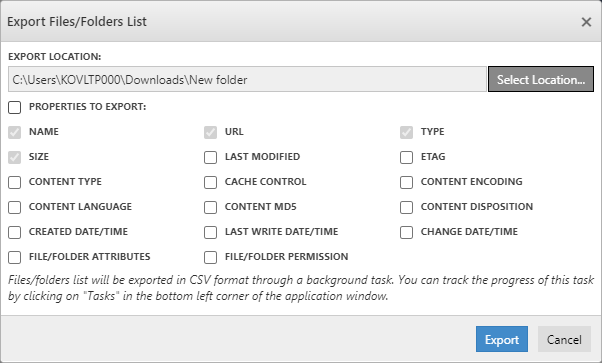
Manage Snapshots
File share snapshot created a read-only copy of a file share when the snapshot was taken. Cerbrata provides comprehensive functionality to manage file share snapshots. It is also possible to restore files and folders from a file share snapshot.
Following are steps to manage Snapshots for File Share:
- Select the context menu of the appropriate File Share, and click Manage Snapshots
- Click New Snapshot to create a new snapshot for the selected File Share
It will create a snapshot of File Share with URL and Identifier as shown below:
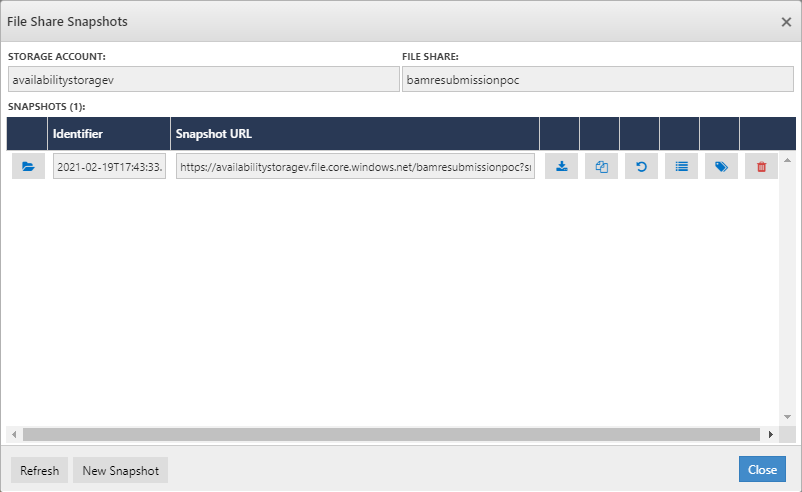
Delete File Share
Consider when a QA team created a Storage File Share to perform testing. When the testing is over, the QA engineer would need to delete that File Share Container in a Storage Account. Here comes Delete option in Cerebrata.
Following are the steps to delete a Storage File Share:
- Select the context menu of the appropriate File Share and click Delete
- It will open a popup and ask User to enter the numbers in "VERIFICATION CODE" box into "CONFIRM CODE" box beside it.
- Once the Verification code is entered, Click Delete to delete the Storage File Share
